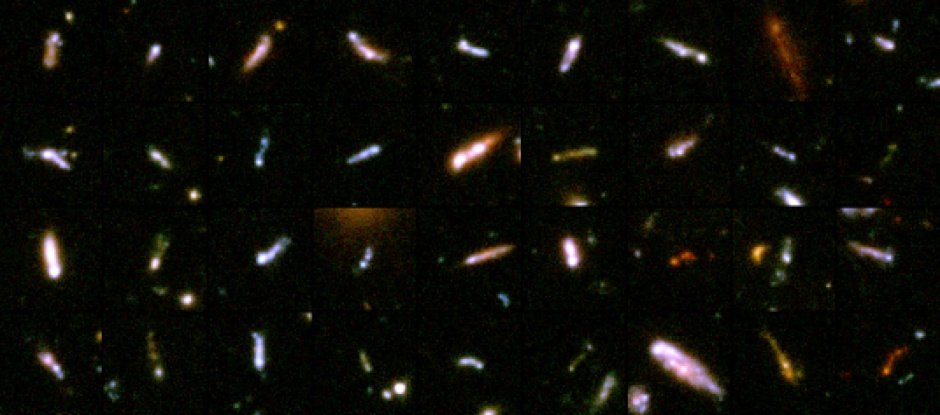원시은하에서 블랙홀의 생성 패턴을 확인하다.
여기 우표크기 정도의 사진들은 아주 멀리 존재하는 은하들로서 다른 은하들과 합병되는 과정에 있는 36개 은하들의 사진이다.
이 은하들은 수십억년전 은하들의 모습을 보여주고 있다.
천문학자들은 이 은하들의 둥근몸체와 꼬리 모양 때문에 '올챙이 은하(Tadpole Galaxy)'라고 이름지었다.
2004년 허블은 'Ultra Deep Field(HUDF)'를 이용하여 수천장의 먼 은하들을 촬영했다.
이 은하들은 연구팀이 HUDF를 이용하여 최근까지 연구해온 165개가 넘는 은하들 중 일부이다.
연구팀은 이 은하들에서 블랙홀의 흔적을 찾아왔다.
블랙홀의 활동 중 주목할만한 특징은 밝기의 지속적인 변화가 발생한다는 데에 있는데, 이것은 블랙홀이 주위의 가스와 별들을 집어삼기면서 발생하는 현상이다.
이처럼 흐릿한 빛은 블랙홀 자체에서 발산되는 것이 아니라, 블랙홀 주변, 근접영역에서 발산되는 것이다.
천문학자들은 기존에 관측대상이 되었던 올챙이 은하들에서는 어떠한 빛의 변화도 발견하지 못했지만 HUDF를 통해서 관찰한 46개의 희미한 은하들에서는 빛의 변화현상을 발견했다.
이 은하들은 올챙이 은하의 모습을 띈 후 수백만년이 지난 상태의 은하들이었다.
이러한 현상은 블랙홀의 활동이 은하들이 막 병합을 시작할 때는 발생하지 않는다는 점을 나타낸다.
은하간의 충돌로부터 가스와 별들이 생성되는 수백만년이 흐른 후에서야, 가스와 별들을 집어삼키는 블랙홀의 활동이 시작되면서 깜빡이는 빛이 나타나게 되는 것이다.
이러한 관측결과는 블랙홀이 주변 별과 가스들을 빨아들이는 현상이 은하의 병합이 발생한 후에서야 관찰가능하다는 최근 컴퓨터 계산에서 예견한 결과와 일치하는 것이다.
각각의 이미지의 크기는 8만 4천 광년에 해당하는 크기로 오늘날 우리 은하의 크기 정도이다.
각 이미지의 중앙부에 보이는 올챙이 은하들은 오늘날의 거대한 은하들의 규모에 비하면 확연히 작은 크기이다.
이 이미지는 허블의 ACS( Advanced Camera for Surveys)로 촬영되었다.
=======================================================================================================================
허블망원경을 통해 이룩한 과학적 발견 -5-의 소개문
허블 우주 망원경이 여러 은하들의 중심부를 탐색한 결과 이들 중 상당수 은하에 초거대 질량을 가진 블랙홀이 있다는 결정적인 증거를 발견했다.
이들 거대한 블랙홀들은 태양 질량의 수백만백에서 수십억 배에 이르는 '괴물'들이다.
이들의 질량은 상상을 초월할 정도로 커서 주위의 모든 물체들을 잡아삼키고 있다.
딱히 뭐라 설명하기 어려운 이들 '걸신들린 천체'들은 직접적으로 관측되는 천체는 아니다.
왜냐하면 모든 것이, 심지어는 빛조차도 이들로부터 벗어날 수 없기 때문이다.
그러나 관측에서 발견된 간접적인 증거들은 이들의 존재를 확실히 증거해 주고 있다.
천문학자들은 허블을 통해서 이들 주변의 물체들이 회전하는 속도를 측정함으로써 블랙홀들의 질량을 계산할 수 있었다.
그간 여러 은하들의 측정 결과를 보면 은하들과 이들이 보유한 블랙홀 간에는 상당히 밀접한 관계들이 있음을 보여주고 있다.
여러 조사들에서 블랙홀의 질량은 그들이 존재하는 은하의 중심부, 빽빽한 별들로 구성되어 있는 은하의 중심부 질량과 상관관계가 있음이 밝혀졌다.
큰 질량의 블랙홀을 가진 은하일수록 보다 작은 질량의 작은 블랭홀보다 규모가 훨씬 크다.
이러한 밀접한 상관관계는 블랙홀이 은하들과 공생하고 있다는 증거가 될 수 있을 것이다.
=========================================================================================================================
* '허블사이트'의 게시물들은 허블사이트 http://hubblesite.org 의 뉴스센터 자료들을 번역한 자료들입니다
ABOUT THIS IMAGE:
These postage-stamp-size images reveal 36 young galaxies caught in the act of merging with other galaxies. These galaxies appear as they existed many billions of years ago. Astronomers have dubbed them "tadpole galaxies" because of their distinct knot-and-tail shapes, which suggest that they are engaging in galactic mergers.
The galaxies were captured in 2004 in the Hubble Space Telescope's Ultra Deep Field (HUDF) survey of thousands of distant galaxies. They are part of more than 165 tadpole galaxies in the HUDF studied recently by a team of astronomers. The team was looking for indications of black hole activity in these young galaxies. A characteristic signature of such activity is a fluctuation in brightness over time, an indication that a black hole is feasting on surrounding stars and gas. The flickering light does not come from the black hole itself but from the area immediately surrounding the black hole. Astronomers did not see brightness fluctuations in any of the tadpole galaxies they surveyed. They did, however, observe the fluctuations in 46 different faint galaxies in the HUDF. These galaxies existed millions of years after the tadpole galaxies. This result suggests that black holes did not begin eating when galaxies merged. Rather, it took several hundred million years for the gas and stars from the merger to arrive on the black hole's dinner plate and become visible as flickering light. This finding agrees with recent computer models which predicted that the feeding habits of black holes would become visible after galactic mergers.
Each postage-stamp image is roughly 84,000 light-years on a side, which is about the size of our Milky Way Galaxy today. The tadpole galaxies are shown in the middle of each image and are considerably smaller than today's giant galaxies. The image was taken by Hubble's Advanced Camera for Surveys.
=======================================================================================================================
Hubble probed the dense, central regions of galaxies and provided decisive evidence that supermassive black holes reside in many of them. Giant black holes are compact "monsters" weighing millions to billions the mass of our Sun. They have so much gravity that they gobble up any material that ventures near them.
These elusive "eating machines" cannot be observed directly, because nothing, not even light, escapes their grasp. But the telescope provided indirect, yet compelling, evidence of their existence. Hubble helped astronomers determine the masses of several black holes by measuring the velocities of material whirling around them.
The telescope's census of many galaxies showed an intimate relationship between galaxies and their resident black holes. The survey revealed that a black hole's mass is dependent on the weight of its host galaxy's bulge, a spherical region consisting of stars in a galaxy's central region. Large galaxies, for example, have massive black holes; less massive galaxies have smaller black holes. This close relationship may be evidence that black holes co-evolved with their galaxies, feasting on a measured diet of gas and stars residing in the hearts of those galaxies.
=======================================================================================================================
'3. 천문뉴스 > 허블사이트' 카테고리의 다른 글
| 허블망원경을 통해 이룩한 과학적 발견 -7- (0) | 2007.11.18 |
|---|---|
| 허블망원경을 통해 이룩한 과학적 발견 -6- (0) | 2007.11.18 |
| 허블망원경을 통해 이룩한 과학적 발견 -4- (0) | 2007.11.17 |
| 허블이 관측한 홈즈 혜성 (0) | 2007.11.17 |
| 허블망원경을 통해 이룩한 과학적 발견 -3- (0) | 2007.11.15 |
